 I have just received a new book, Aldhelm and Sherbourne – essays to celebrate the founding of the bishopric edited by Katherine Barker and Nicholas Brooks, published by Oxbow Books last year. I ordered this book of conference papers because it includes an audio CD of a performance of one of Aldhelm’s Latin lyrics, the Carmen rythmicum, as performed by a “Finnish rune-singer” accompanied with kantele.
I have just received a new book, Aldhelm and Sherbourne – essays to celebrate the founding of the bishopric edited by Katherine Barker and Nicholas Brooks, published by Oxbow Books last year. I ordered this book of conference papers because it includes an audio CD of a performance of one of Aldhelm’s Latin lyrics, the Carmen rythmicum, as performed by a “Finnish rune-singer” accompanied with kantele.
Aldhem was a late 7th -early 8th century Anglo Saxon Christian priest in the south-west of England, and the book is an erudite and scholarly series of papers discussing various aspects of his life and work, and especially his connection to the ecclesiastical centre at Sherbourne which he founded in 705.
The preface and introduction are quite personal and intimate, and you get the impression that the organisers and scholars in this field are all close friends. The papers vary a lot, from historical and geographical surveys of the region, to detailed linguistic analyses. Barbara Yorke’s survey of Aldhelm’s Irish and British connections is especially interesting as a broad overview of cultural connections at this time. David Howlett’s numerological layout of the Latin life of Aldhelm is baffling in its application of number and letter counting and lack of explanation or discussion, and Katherine Barker’s discussion of Aldhelm as composer and author of the Carmen rythmicum is rather too ready to identify Latin musical terms with modern instrument categories (e.g. I would be suspicious of translating Aldhelm’s psalterium with “psaltery” without comment), but is a very thought provoking discussion of musical learning and practice in early medieval times.
The audio CD, with a single 35 minute track, is not a live recording of the conference performance, but a later studio version. The two performers are described as Masters students at Sibelius Institute and I found the performance style to be quite modern, much cleaner and more ‘professional’ sounding than the archive recordings of traditional Finnish singers I have heard. The text is in lines of 8 syllables, and the singers use the same even-spaced 8 syllable metre that is used for Kalevala singing, where each syllable is of equal length except for extended final syllables. To my mind this is less successful for the Latin verse, since my understanding of Latin meter is that it is strongly based on the alternation of feet containing long and short syllables. I also hear no trace of the Carmen‘s distinctive three syllable line ending, with the third from last stressed, and the second from last short (described here). The kantele is sometimes strummed, sometimes plucked, and complements the voices well, though some sections seemed a little too contrapunctal for my taste.
But, it is still a very interesting project, and the inclusion of the CD makes it almost unique and highly recommended. Also, the way that the book provides not only a complete Latin text of the song but also a number of different translations by different scholars really allows for a rich appreciation of this material.